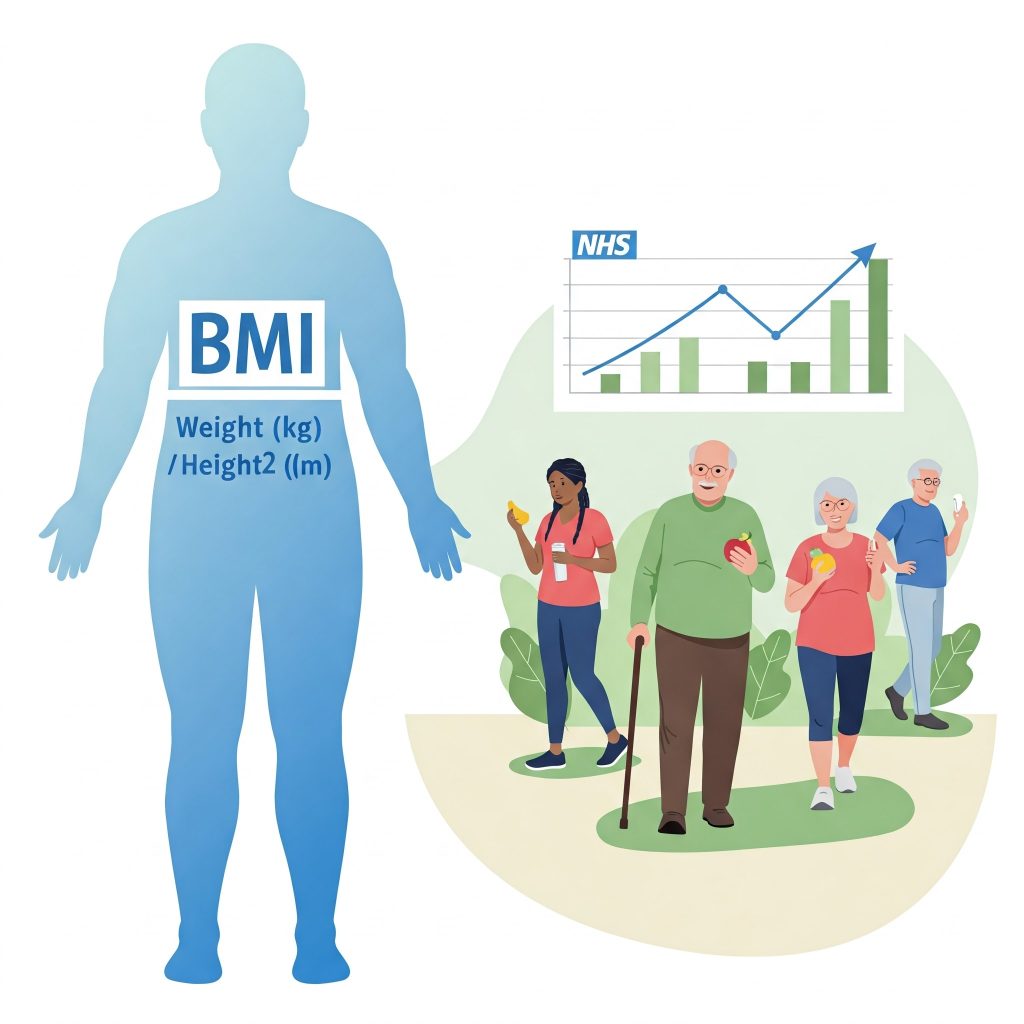
Body Mass Index (BMI) is one of the most widely used tools for assessing whether a person’s weight is within a healthy range. The NHS uses BMI as a quick, simple, and effective way to evaluate potential health risks linked to obesity and underweight conditions.
✔ A cost-effective screening tool used in medical check-ups.
✔ Helps identify individuals at risk of chronic diseases such as heart disease and diabetes.
✔ Plays a key role in public health research and obesity prevention efforts in the UK.
What is BMI and How is it Calculated?
Understanding BMI
BMI is a numerical value calculated using a person’s weight and height. It categorises individuals into different weight groups to help assess overall health risks.
BMI Calculation Formula
✔ Metric formula: BMI = Weight (kg) ÷ Height (m²)
✔ Imperial formula: BMI = (Weight (lbs) ÷ Height (in²)) × 703
NHS BMI Classification Chart
| BMI Range | Category | Health Risk |
|---|---|---|
| Below 18.5 | Underweight | Increased risk of malnutrition, osteoporosis |
| 18.5 – 24.9 | Healthy Weight | Lowest health risk |
| 25 – 29.9 | Overweight | Moderate risk of heart disease, diabetes |
| 30 and above | Obese | High risk of chronic diseases |
📌 Check Where You Fall on the NHS BMI Chart
Why the NHS Uses BMI for Health Assessments
1. Quick and Simple Screening Tool
✔ BMI is fast, easy to measure, and cost-effective compared to other body composition methods.
✔ NHS professionals use it as a first step before recommending additional health assessments.
2. Helps Identify Risk of Chronic Diseases
✔ A higher BMI is linked to increased risks of conditions like heart disease, stroke, and Type 2 diabetes.
✔ BMI is used by doctors to assess whether lifestyle changes or medical interventions are necessary.
🔗 How BMI Affects Health Risks
3. Supports Public Health Research & Obesity Monitoring
✔ The NHS tracks BMI trends to study obesity levels in the UK population.
✔ Helps in developing public health campaigns, weight loss programmes, and prevention strategies.
📌 Learn More About the NHS Weight Loss Plan
Limitations of BMI – Why It’s Not Always Accurate
While BMI is widely used, it has some limitations that should be considered.
1. Does Not Differentiate Between Fat and Muscle
✔ Athletes and individuals with high muscle mass may have a high BMI despite being healthy.
✔ BMI cannot distinguish between fat mass, muscle, or bone density.
2. May Not Be Suitable for Certain Groups
✔ BMI does not account for differences in age, gender, or ethnicity.
✔ Pregnant women and older adults may have BMI classifications that don’t accurately reflect their health.
🔗 BMI vs Body Fat Percentage – Which is More Accurate?
Alternatives to BMI Used by the NHS
While BMI is useful, the NHS may also consider other health assessment tools:
✔ Waist-to-Hip Ratio (WHR) – Measures fat distribution around the waist.
✔ Body Fat Percentage – Provides a more detailed view of body composition.
✔ Waist Circumference – Used to assess central obesity risks.
📌 Check Your Waist-to-Hip Ratio Here
Should You Rely on BMI Alone?
✔ BMI is useful for general health screening but should not be used as the only measure of health.
✔ For a full health assessment, consider:
- Blood tests for cholesterol and blood sugar levels.
- Body fat measurements for a more accurate fat-to-muscle ratio.
- Lifestyle factors such as diet, physical activity, and medical history.
📌 Check Your BMI with Our Free Calculator
Frequently Asked Questions (FAQs)
1. Why Does the NHS Still Use BMI?
✔ BMI is a quick and widely accepted method for assessing weight-related health risks.
2. Is BMI an Accurate Measure of Health?
✔ BMI provides a general health indicator, but does not measure fat percentage or muscle mass.
3. What BMI is Considered Healthy?
✔ A BMI between 18.5 and 24.9 is classified as a healthy weight.
📌 Check Your BMI with Our NHS-Approved Tool
Final Thoughts – Why the NHS Uses BMI
✔ BMI remains an essential tool for quick and cost-effective health screenings.
✔ The NHS uses BMI to track public health trends and guide healthcare recommendations.
✔ However, it is best to consider other health factors alongside BMI for a complete assessment.
📌 Use the NHS BMI Calculator Now




